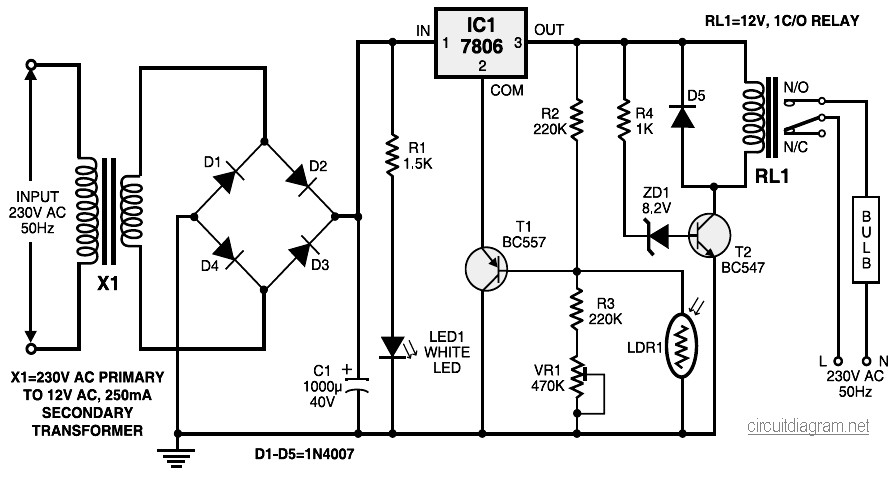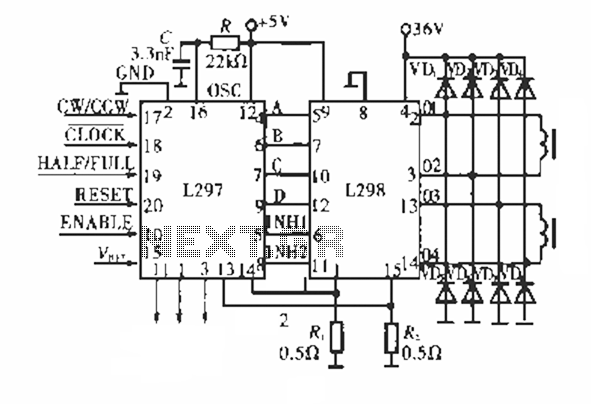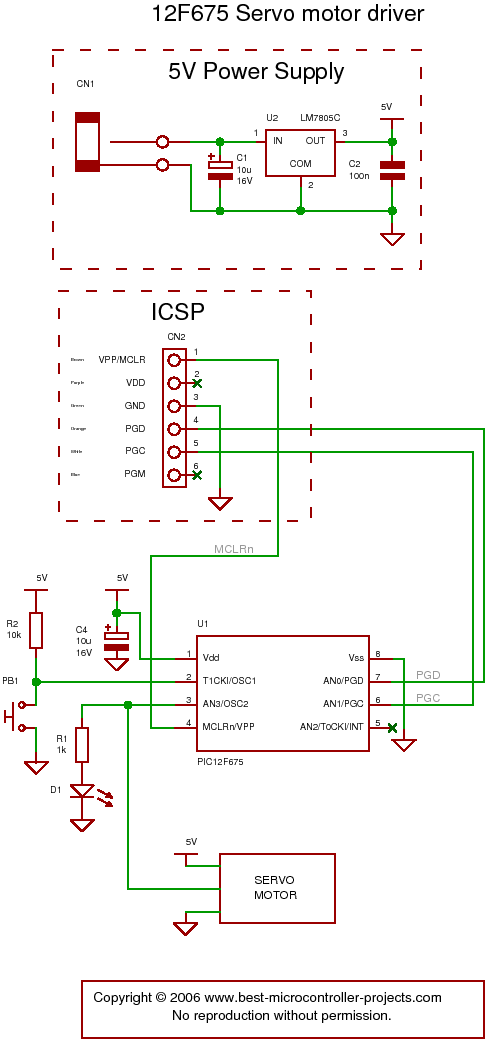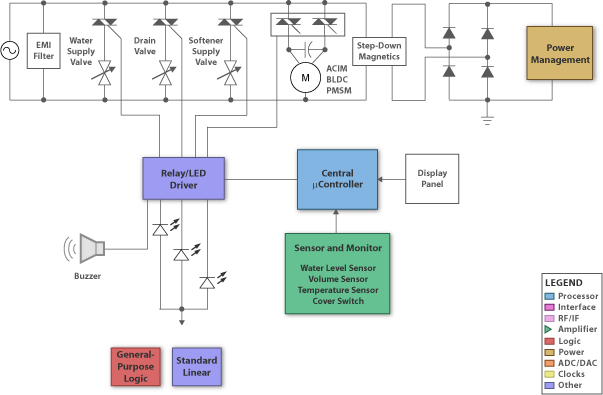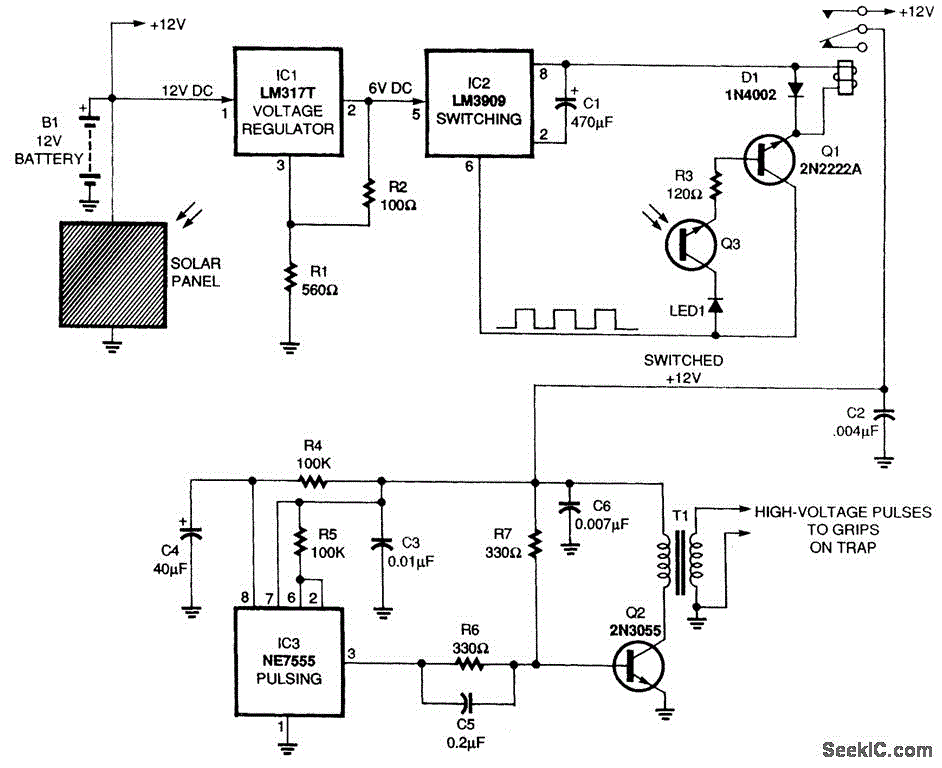
DC Motor Speed Controller
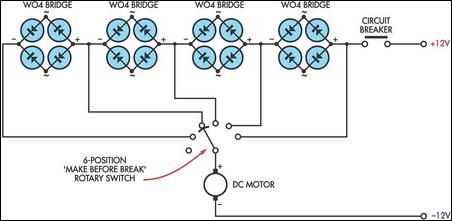
This circuit utilizes the voltage drop across bridge rectifier diodes to create a 5-position variable voltage supply for a DC fan or other small DC motors. While it is not as efficient as a switch-mode circuit, it offers advantages such as simplicity and the absence of switching noise. The four full-wave bridge rectifiers are configured so that each contains two pairs of diodes in parallel, resulting in a voltage drop of approximately 1.4V, which is dependent on the load current. The rotary switch should feature make-before-break contacts that are rated to handle currents of up to about one amp. For applications requiring higher currents, it is necessary to use higher-rated bridge rectifiers along with a robust rotary switch or solenoids. To achieve smaller voltage steps, the common AC inputs on the bridge rectifiers can be utilized to provide intermediate voltage levels on the speed switch.
This circuit design employs a series of four bridge rectifiers to achieve variable voltage output. Each bridge rectifier consists of four diodes arranged in a configuration that allows for full-wave rectification, converting AC input into DC output. The parallel arrangement of diode pairs within each bridge rectifier facilitates a consistent voltage drop, which is critical for maintaining the desired output levels across the multiple positions of the rotary switch.
The rotary switch plays a pivotal role in this circuit, allowing for the selection of different voltage levels. The make-before-break design ensures that there is no interruption in the current flow during the switching process, which is essential for preventing voltage spikes that could damage sensitive components. The current rating of the switch must be carefully considered to match the load requirements, as exceeding the switch's capacity can lead to overheating or failure.
For applications requiring higher power, it is advisable to use bridge rectifiers that are rated for greater current loads, as well as a rotary switch or solenoid that can handle the increased demand. The use of solenoids may introduce additional complexity to the circuit but can provide a more robust solution for high-current applications.
To refine the voltage output further, utilizing the common AC inputs of the bridge rectifiers allows for the generation of intermediate voltage steps. This can be particularly useful for applications where precise control over the motor speed is necessary. By adjusting the connections to the AC inputs, the circuit can provide a finer granularity of voltage adjustments, enhancing the overall functionality of the variable voltage supply.
In summary, this circuit offers a practical solution for providing variable voltage to DC motors, balancing simplicity with functionality. Careful consideration of component ratings and configurations will ensure reliable operation across a range of applications.This circuit takes advantage of the voltage drop across bridge rectifier diodes to produce a 5-position variable voltage supply to a DC fan or other small DC motor. It is not as efficient as a switch-mode circuit but it has the virtues of simplicity and no switching hash.
The four full-wave bridges are connected so that each has two pairs of serie s diodes in parallel, giving a voltage drop of about 1. 4V, depending on the load current. The rotary switch should have make before break contacts which should be rated to take currents up to about an amp or so. For higher currents, higher rated bridge rectifiers and a suitably rugged rotary switch (or solenoids) will be required.
If you want smaller voltage steps, you could use the commoned AC inputs on the bridge rectifiers to give intermediate steps on the speed switch. 🔗 External reference
This circuit design employs a series of four bridge rectifiers to achieve variable voltage output. Each bridge rectifier consists of four diodes arranged in a configuration that allows for full-wave rectification, converting AC input into DC output. The parallel arrangement of diode pairs within each bridge rectifier facilitates a consistent voltage drop, which is critical for maintaining the desired output levels across the multiple positions of the rotary switch.
The rotary switch plays a pivotal role in this circuit, allowing for the selection of different voltage levels. The make-before-break design ensures that there is no interruption in the current flow during the switching process, which is essential for preventing voltage spikes that could damage sensitive components. The current rating of the switch must be carefully considered to match the load requirements, as exceeding the switch's capacity can lead to overheating or failure.
For applications requiring higher power, it is advisable to use bridge rectifiers that are rated for greater current loads, as well as a rotary switch or solenoid that can handle the increased demand. The use of solenoids may introduce additional complexity to the circuit but can provide a more robust solution for high-current applications.
To refine the voltage output further, utilizing the common AC inputs of the bridge rectifiers allows for the generation of intermediate voltage steps. This can be particularly useful for applications where precise control over the motor speed is necessary. By adjusting the connections to the AC inputs, the circuit can provide a finer granularity of voltage adjustments, enhancing the overall functionality of the variable voltage supply.
In summary, this circuit offers a practical solution for providing variable voltage to DC motors, balancing simplicity with functionality. Careful consideration of component ratings and configurations will ensure reliable operation across a range of applications.This circuit takes advantage of the voltage drop across bridge rectifier diodes to produce a 5-position variable voltage supply to a DC fan or other small DC motor. It is not as efficient as a switch-mode circuit but it has the virtues of simplicity and no switching hash.
The four full-wave bridges are connected so that each has two pairs of serie s diodes in parallel, giving a voltage drop of about 1. 4V, depending on the load current. The rotary switch should have make before break contacts which should be rated to take currents up to about an amp or so. For higher currents, higher rated bridge rectifiers and a suitably rugged rotary switch (or solenoids) will be required.
If you want smaller voltage steps, you could use the commoned AC inputs on the bridge rectifiers to give intermediate steps on the speed switch. 🔗 External reference
Warning: include(partials/cookie-banner.php): Failed to open stream: Permission denied in /var/www/html/nextgr/view-circuit.php on line 713
Warning: include(): Failed opening 'partials/cookie-banner.php' for inclusion (include_path='.:/usr/share/php') in /var/www/html/nextgr/view-circuit.php on line 713
